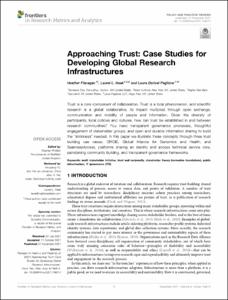| dc.contributor.author | Flanagan, Heather | |
| dc.contributor.author | Haak, Laurel | |
| dc.contributor.author | Paglione, Laura | |
| dc.date.accessioned | 2022-07-05T19:59:19Z | |
| dc.date.available | 2022-07-05T19:59:19Z | |
| dc.date.issued | 2021 | |
| dc.identifier.citation | Flanagan,,H., Haak, L.L. and Paglione, L.D. (2021) Approaching Trust: Case
Studies for Developing Global Research Infrastructures.
Frontiers in Research Metrics and Analytics, 6:746514, 12pp.
DOI: 10.3389/frma.2021.746514 | en_US |
| dc.identifier.uri | https://repository.oceanbestpractices.org/handle/11329/1979 | |
| dc.description.abstract | Research is a global endeavor of iteration and collaboration. Research requires trust-building: shared
understanding of process, access to source data, and points of validation. A number of trust
structures are used by researchers: disciplinary societies cohere practices among researchers,
educational degrees and institutional affiliation are proxies of trust, as is publication of research
findings in status journals (Haak and Wagner, 2021).
These trust structures require interactions among many stakeholder groups, operating within and
across disciplines, institutions, and countries. This is where research infrastructures come into play.
These infrastructures support knowledge sharing across stakeholder borders, and at the best of times
create a foundation for collaboration (Edwards et al., 2013; Haak et al., 2020). Examples of globalscale
research infrastructures include article indexing platforms, researcher profile systems, federated
identity systems, data repositories, and global data collection systems. More recently, the research
community has started to pay more interest to the governance and sustainability aspects of these
infrastructures (Bilder et al., 2020; Skinner, 2019). Organizations such as the Research Data Alliance
have fostered cross-disciplinary self-organization of community stakeholders, out of which have
come truly amazing consensus rules of behavior—principles of findability and accessibility
(Wilkinson et al., 2016), as well as responsibility and ethics (Carroll et al., 2020)—that can be
applied to infrastructures to improve research rigor and reproducibility and ultimately improve trust
and engagement in the research process.
In this article, we share our “in the trenches” experiences of how these principles, when applied in
practice, can drive research infrastructure adoption. Infrastructure is more than a platform, it is a
public good, so we need to ensure its accessibility and sustainability. How it is constructed, governed, and maintained requires intentional engagement and alignment
of diverse stakeholders across social and economic factors to
maximize trust, utility and impact on public welfare (Dhanshyam
and Srivastava, 2021). What we have found is that without
alignment and engagement, trust-building suffers. The lower
the trust—even for a really strong technology that is
desperately needed by the research community—the steeper
the uphill push to adopt and implement the infrastructure. | en_US |
| dc.language.iso | en | en_US |
| dc.rights | Attribution 4.0 International | * |
| dc.rights.uri | http://creativecommons.org/licenses/by/4.0/ | * |
| dc.subject.other | Research infrastructures | en_US |
| dc.title | Approaching Trust: Case Studies for Developing Global Research Infrastructures. | en_US |
| dc.type | Journal Contribution | en_US |
| dc.description.refereed | Refereed | en_US |
| dc.format.pagerange | 12pp. | en_US |
| dc.identifier.doi | 10.3389/frma.2021.746514 | |
| dc.subject.parameterDiscipline | Cross-discipline | en_US |
| dc.bibliographicCitation.title | Frontiers in Research Metrics and Analytics | en_US |
| dc.bibliographicCitation.volume | 6 | en_US |
| dc.bibliographicCitation.issue | Article 746514 | en_US |
| dc.description.adoption | Validated (tested by third parties) | en_US |
| dc.description.methodologyType | Reports with methodological relevance | en_US |
| obps.contact.contactname | Laurel L. Haak | |
| obps.contact.contactemail | laure@mightyredbarn.com | |
| obps.resourceurl.publisher | https://www.frontiersin.org/articles/10.3389/frma.2021.746514/ | |
 Repository of community practices in Ocean Research, Applications and Data/Information Management
Repository of community practices in Ocean Research, Applications and Data/Information Management

